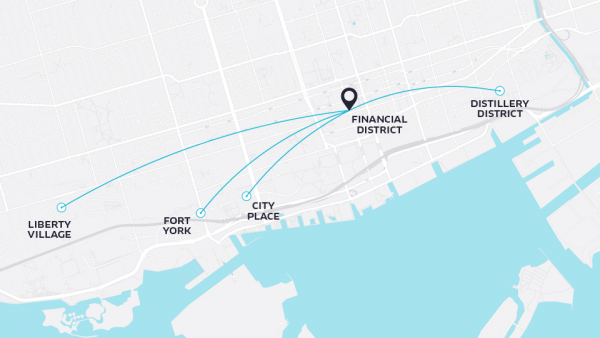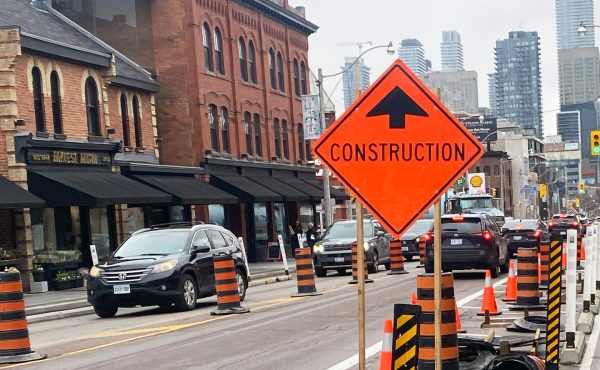On Friday, John Lornic made an interesting case that UberHop, the controversial new service launched by the San Francisco-based “ridesharing” business, is the kick in the behind that the TTC needs to take seriously the problem of getting across the downtown core.
Lornic makes an important point: UberHop will be susceptible to the same congestion that plagues the 504 King Streetcar, the TTC’s busiest surface route. The King car carries nearly 65,000 passengers a day, but congestion and overcrowded streetcars and shuttle buses along the line have made it difficult for commuters along the line. This is why private-sector alternatives, like the short-lived Line 6 shuttle bus, seem so appealing. Now Uber is giving the private jitney service a try, looking to fill a need in the marketplace for $5 a ride.
But there is a solution that the TTC has looked at and proposed — a King Street Transit Mall — but sunk by local opposition and City Council’s indifference. I wrote more about the idea on my blog.
Rapid residential growth, both east and west of the downtown core, have overloaded the 504 King Streetcar. With 64,600 daily riders, it’s the busiest surface route in the system. The city has done little to facilitate this highrise boom in neighbbourhoods such as Corktown and the Distillery District in the east, and CityPlace, Liberty Village, Niagara, and Queen/Gladstone in the west. Further west, the highrise condos built at Humber Bay Shores must either rely on a painfully slow and unreliable ride on the 501 Queen Streetcar, take an infrequent double-fare express bus, or ride a bus up to the Bloor Subway.
No wonder then, Uber, the controversial firm that has delighted passengers with cheap transportation, but put the livelihoods of taxi drivers in jeopardy, launched UberHop, a variation of its “ride sharing” service that offers flat $5 rides between neighbourhoods along the King Streetcar and the downtown core. From a purely capitalist viewpoint, Uber is filling a need that’s been left unfulfilled.
Of course, with UberHop, Uber is probably in violation of the TTC’s monopoly on public transportation within the City of Toronto. This is a law that’s been on the books since 1921, meant to protect the TTC from illegal jitneys and competition from private bus operators. It allows the system to cross-subsidize unprofitable routes that are necessary to form a complete network; private companies, without subsidies, would just cherry-pick profitable routes.
A subway, like the oft-proposed and oft-ignored Relief Line would be a fine solution to east-west transit congestion in Downtown Toronto, especially if the route extended west of Downtown to serve neighbourhoods such as Fort York and Liberty Village. GO Regional Express Rail (RER), and/or John Tory’s SmartTrack, could provide some relief to streetcars on King and Queen Streets, especially if the service levels, fares, and stations are convenient.
But the King Street Transit Mall is the low-hanging fruit that could not only provide some reliability to the King Car, but also make things a little harder for UberHop.
The transit mall was first proposed in 2001. Reserved lanes, painted in 1993, didn’t work. Police weren’t interested in enforcing the transit lanes, or ticketing cars and trucks illegally stopping or parking during rush hours, so the TTC wanted to try something more effective and permanent: it would ban all through traffic on King Street between Dufferin and Parliament Streets, while allowing deliveries, passenger drop-offs and other services in alternating curb lanes. Pedestrians would benefit from wider sidewalks, there would even be room for patios, greenery and programmed spaces. The result would be a reliable, efficient King Street for the majority of the street’s users – streetcar riders, and pedestrians. You can read more about it at Transit-Toronto, here.
TTC image illustrating the 2001 King Street streetcar right-of-way proposal. Image via Transit-Toronto.
The TTC’s ambitious, yet affordable, plan to improve King Street service was deep-sixed by city council. Merchants complained about the loss of parking, and the difficulties of deliveries and garbage collection. They feared a loss of customers. (Never mind many, if not most of the restaurants’ clientele arrived by foot or transit.) It never had a chance.
Again, in 2007, the TTC proposed a pilot project to improve operations on the King Streetcar during the summer months of 2008. It was a less ambitious proposal than the one pitched in 2001, which would only last during July and August, between Simcoe Street and Spadina Avenue. Again, local business owners and a car-friendly city council successfully opposed it.
Interestingly, last September, the city closed King Street between Simcoe and Peter Streets entirely for the benefit of the Toronto International Film Festival, forcing the TTC to split its busiest surface route into two. Even though TTC staff recommended against the closure, was Scarborough Councillor Glenn De Baeremaeker moved the TIFF-friendly motion. While De Baeremaeker has been championing a Scarborough Subway, he and his fellow councillors decided that King streetcar riders weren’t deserving enough.
The City of Toronto planned and approved residential development along the King and Queen Street corridors and new office space downtown, but it has done almost nothing to help move these new residents and employees. UberHop is only the symptom; an ineffective municipal government is the problem.







18 comments
Move the street car tracks to the side and raise them up like on St Clair and make King and Queen one way streets
Toronto’s streetcars move hundreds of thousands of people every day – each one carrying at rush hour over 80 passengers on average. Single occupant vehicles are choking our streets and our lungs. City Council needs to recognize the inefficiency of private vehicles for commuting into town, and release parking lots for development and streets for transit, bikes, and walking. Many European cities have done this and have thrived.
This comes on the heels of a conversation I had with someone who knows City Hall inside and out. This person’s observation was that there is no one, NO ONE, on this council who is truly interested in city-wide transit issues. Until there is, nothing sensible will happen.
Well, OK, it’s fine in theory – but what IS the answer to garbage collection? How do you enforce “no through-traffic” but still allow people to drive to/from their condo parking lots?
The problem with the proposal is that it’s entirely half-baked and hasn’t been properly designed. Somebody – whether it’s the BIA or somebody else – needs to commission an actual study that would address all of the issues. That way, when they are brought up by grumpy old people, they can be addressed one by one. Only then will you get anywhere. “Ideas” are a dime a dozen unfortunately, and aren’t given a second thought because there are so many of them.
A black and white vignette from 2001 just doesn’t cut it, and you’d need the FULL support of the BIA to actually get anywhere.
Return to using cobblestones between the tracks, especially downtown.
I fully agree with Christopher King, make King and Queen into one way streets. You can keep parking along the streets and traffic will move much better – individual traffic as well as public transport. And include bike lanes, every person on a bike is one lesser in a car or in a streetcar.
You’re joking right, JFS_II?
Garbage collection? Condo accessibility? Wow – are those really dealbreakers to this exercise? Give me a break, no one is suggesting that the full assessments wouldn’t be required here, what we’re lacking is the courage and vision from anyone in Council to champion a real idea to address transit issues like this one.
And the BIA? Seriously? Just like the St. Clair BIA was in full opposition of the streetcar ROW there? Until it wasn’t? Because if you’ve been to St. Clair lately, things are certainly looking fairly healthy and gentrified to me… BIA are important stakeholders but certainly not the ones we should heed to, since businesses WILL NEVER have the full socioeconomic interests of the communities they serve… just the short-shorted economic ones….
Toronto city hall tries not to offend anybody and ends up pleasing nobody. They very rarely show the vision or courage to take the city forward.
Adopt a solution that has helped New York so much… make King and Queen one-way streets in opposing directions. Each road could accommodate a lane all parties needing the road: LANE 1 (right lane) for parked cars; LANE 2: streetcars/bikes lanes, MIDDLE LANE: through traffic; LEFT LANE: through traffic/left-turning vehicles. EVERYBODY WINS! The infrastructure is already in place, it would literally cost nothing to us all, and traffic would flow much more efficiently.
Taxi driver are also suffering government is doing nothing stop uber
Want to decrease congestion by 50% on the major streets like King and Queen? Extend the no parking, no stopping and no standing times from 7am to 7pm, 7 days a week. Yes the BIAs would complain about parking. But razing 3 buildings in the middle of a block and building an above and below ground parking lot would solve that problem.
JFS_II – I’m sorry, but I don’t think you’re critique is on target.
As you can see from the plan vehicles like delivery trucks (and garbage trucks) can access the businesses. Local business owners are worried about garbage collection because people are afraid of the unknown. Just because those people have fears does NOT mean the fears are well-founded.
Similarly it is ridiculous to say we need 100% buy in from BIAs to get anything done. I don’t remember when we gave businesses a veto over decisions affecting the city as a whole and the welfare of hundreds of thousands of its residents – because we never did. And of course the local businesses ALWAYS complain when you talk about reducing parking: once again, simply a fear that is NOT well founded since in these areas by far the preponderance of customers are NOT in cars, and of course research also shows that pedestrian shoppers stay longer and shop more, and of course the precious free market can supply parking at a green P or condo or office building.
BIA members are getting a massive subsidy, when MY streets are being allocated to the private use of their customers for almost nothing. It’s ridiculous that one person picking up dry cleaning thinks they’re *entitled* to park on a city street for nothing, and the BIA people feel *entitled* to have that street converted to their use, slowing or stopping traffic for tens of thousands of people in line behind them.
The local businesses SAY they want street parking, but they have no idea what they’re talking about commercially or economically, they just don’t want to give up the massive freebie that taxpayers give them each day in the form of our streets.
” How do you enforce “no through-traffic” but still allow people to drive to/from their condo parking lots?”
And this is the part where you make fun of the black and white image from 2001, but didn’t take the time to look at it. The method is alternating single lane one-ways. Same as the delivery trucks. Not complicated and drawn right on the thing and you still couldn’t figure it out?
Toronto as a whole really needs to step up, it is no longer the provincial town it once was. Its crystal clear what needs to happen (tolls on the major highways, congestion charges during the weekdays, subway relief line, signal prioritization for streetcars and more dedicated ROWs). These issues have been studied and talked about to death.
John Tory campaigned as if he would be the polished and intelligent leader the city never had. One year in and what has he done for transit aside from towing some parked cars. He invested his political capital in SmartTrack, a provincial project which mainly benefits 905 residents, instead of the Relief Line. And the only project under discussion is a Scarborough Subway. Wake up Toronto.
Uber drivers are creating more more traffic on downtown core and our streets
Gavin – my question is about enforcement. You can SAY “No through traffic”, but there are going to be a LOT of people that need to drive down the road, because they live in the area. King Street is very developed, and it’s a real problem. Without a proper strategy in place, it will become a nightmare – you’ll have a similar amount of traffic fighting with the streetcar ROW.
Listen, I’m not at ALL against finding a solution. The point that I’m trying to make – that you’re missing – is that a LOT of details need to be considered BEFORE anyone is going to take this seriously. I think it has a TONNE of merit, but it will never get anywhere, at all, without more consideration of the real questions it will raise. The better prepared one is to answer those questions, the better a chance it has to be tested out in a pilot project for a summer.
The perfect example is laneway housing – people have studied it and proposed it endlessly for the last 30 years, and it’s perfect fodder for grad students and think tanks. But at the end of the day, if you can’t service the property properly, and if you can’t get both a garbage truck and fire truck to the property, it doesn’t matter what you’ve drawn or how nice your renderings look. It just won’t happen. It doesn’t mean it isn’t a GOOD IDEA, but if the “solutions” don’t propose to solve the REAL problems or limits, it’s an exercise in futility.
Just to throw it out there… upgrade the traffic mall concept – block access to King from University to Yonge as a limited access roadway with a fee for use. Deliveries get sent to a centralized location off site (Portlands?) and dedicated trucks (access pre-paid/subsidized/free) deliver early AM. Waste removal handled the same way. All revenue (less delivery/waste subsidies for transit!
As for one ways streets we have Wellington, Adelaide and Richmond. Changing King and Queen to one way would kill the street cars you want to help
In my studies of King Street operations, a few important points emerge:
First, congestion does not stop at Dufferin, and actually the section from Bathurst to Dufferin is relatively free-flowing. There are problems at any road which provides access south to the Gardiner, and these problems move around depending on construction activities and ramp closures.
Second, there is a big problem at Roncesvalles where streetcars are regularly delayed westbound in a queue of traffic that is, mainly, trying to go west on The Queensway.
Third, the section from Church east to Parliament is also free-flowing and would not benefit from reserved lanes.
The point here is that any attempt to improve speeds on the King car should look at locations and times where/when it is actually delayed, not simply blast a right-of-way all the way across the city.
As for a King/Queen one-way pair, this has big problems for two reasons:
First, it increases walking distance to transit stops quite considerably for people whose origins or destinations don’t lie between the two roads. This is a big issue in a world where we are trying to make transit more attractive and eliminate/reduce barriers for those with mobility issues.
Second, if there is only eastbound transit service on King and westbound on Queen, then the combined capacity of the two routes is reduced to the level of service that can be operated on each street in one direction.
King today suffers from too little service, but the big improvement would be to see larger cars replacing the existing ones on a 1:1 basis. Queen is getting the attention now with a new schedule in January that might improve reliability a bit, but what we really need are those long-overdue cars from Bombardier.
Back as we entered this greenhouse century, there was a massive road folly called the Front St. Extension that many supported, but there was no transit option. I fussed a lot and proposed a Front St. transitway which would have expedited the east-west from Parkdale in to the core, and eased the pressures on King/Queen and also provided the flexibility to try out some “roadical” options, like doing one-ways. Alas, while the road eventually withered, nobody in power felt like promoting transit, though c. 2006 I found the 1993 WWLRT EA that actually modelled out a similar Front St. transitway, and totally validated a transitway/restoration of transit to Front. While some chances to do this have been built upon, there is still a slender chance of putting in transit on the north side of the Weston rail tracks starting at Queen/Dufferin and going over to Front and Bathurst. It is more possible as the Meat Packers plant is no longer a pinch point, as they’ve sold, and Metrolinx I think is thinking of expropriating a bit more corridor width – so why not do/ensure the TTC has a semi-express service added in to things too? Even a one-way reversible busway that touches on Liberty Village and thus into the core would be something.
It’s only been maybe a couple of years of mentioning this and a few deputations; I’m tending to avoid calling us “Caronto” but instead think we’re better off being called “Moronto”.